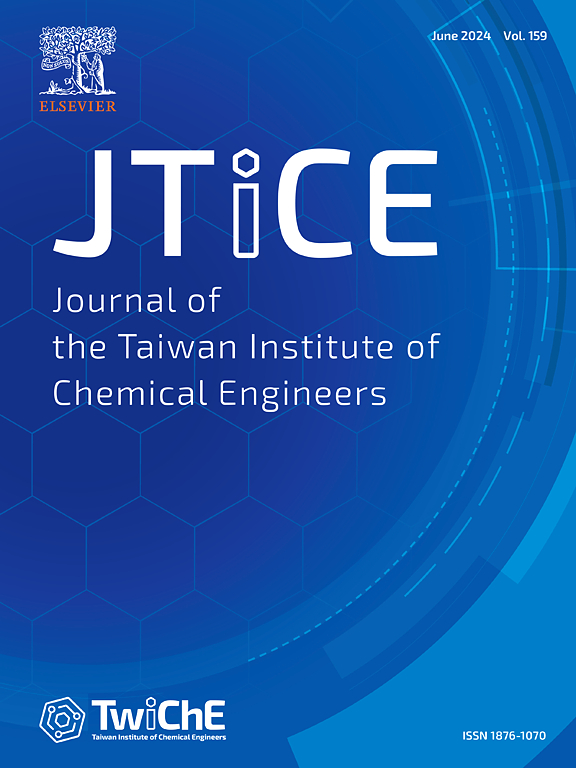Renewable Co@MOF-808(C) catalyzed PMS for the efficient degradation of 2,4-D: Performance and mechanism
IF 5.5
3区 工程技术
Q1 ENGINEERING, CHEMICAL
Journal of the Taiwan Institute of Chemical Engineers
Pub Date : 2025-07-15
DOI:10.1016/j.jtice.2025.106291
引用次数: 0
Abstract
Background
The 2,4-Dichlorophenoxyacetic acid (2,4-D) is widely in agriculture, forestry, and other areas, while it causes environmental pollution problems due to the high chemical stability and poor biodegradability.
Methods
A novel Co3O4-loaded MOF-derived carbon catalyst (Co@MOF-808(C)) was prepared and its catalytic performance of peroxymonosulfate (PMS) for 2,4-D degradation was evaluated.
Significant findings
Results indicated Co@MOF-808(C) could effectively degrade 2,4-D by catalyzing PMS. Under the selected conditions of 500 mg·L⁻¹ Co@MOF-808(C), 3 mM PMS, 45 °C, and without pH adjusting, a remarkable degradation rate (97.3 %) and high mineralization rate (88.7 %) were obtained as 2,4-D concentration was 50 mg·L⁻¹. In addition, the existence of H2PO4⁻, CO32⁻ (5 mM), or SO42⁻ (5 mM) could promote the catalytic degradation of 2,4-D, while other ions (including Cl−, NO3−, and humic acid) and higher concentration of CO32⁻ or SO42⁻ inhibited 2,4-D degradation. Reusability experiment of Co@MOF-808(C) indicated the degradation rate was still remained at 89.4 % after five cycles. Quenching experiment, ESR and XPS results demonstrated SO4−· dominated a crucial role in 2,4-D removal and the Co2+/Co3+ cycle drove the PMS activation. Furthermore, the LC-MS results illustrated the potential degradation pathway for 2,4-D mainly included decarboxylation, dechlorination, hydroxylation, and ring cleavage; and the ecotoxicological results showed an obvious reduction in the toxicity of 2,4-D after degradation. In summary, the stable chemical properties and excellent catalytic effect of Co@MOF-808(C) offered a potential application for 2,4-D elimination form aquatic environment.

可再生Co@MOF-808(C)催化PMS高效降解2,4- d:性能和机理
2,4-二氯苯氧乙酸(2,4- d)广泛应用于农业、林业等领域,但其化学稳定性高,生物降解性差,给环境造成了污染问题。方法制备了一种新型负载co3o4的mof衍生碳催化剂Co@MOF-808(C),并对其催化过氧单硫酸盐(PMS)降解2,4- d的性能进行了评价。结果表明Co@MOF-808(C)可通过催化PMS有效降解2,4- d。在500mg·L⁻¹Co@MOF-808(C)、3mm PMS、45°C、不调节pH的条件下,当2,4- d浓度为50mg·L⁻¹时,得到了显著的降解率(97.3%)和高矿化率(88.7%)。此外,H2PO4毒血症、CO32毒血症(5毫米)或SO42毒血症(5毫米)的存在可以促进2,4- d的催化降解,而其他离子(包括Cl−、NO3−和腐殖酸)和较高浓度的CO32 - SO42毒血症则会抑制2,4- d的降解。Co@MOF-808(C)的重复利用实验表明,经过5次循环后,降解率仍保持在89.4%。猝灭实验、ESR和XPS结果表明,SO4−·在去除2,4- d中起关键作用,Co2+/Co3+循环驱动PMS活化。此外,LC-MS结果表明2,4- d的潜在降解途径主要包括脱羧、脱氯、羟基化和环裂解;生态毒理学结果表明,降解后的2,4- d毒性明显降低。综上所述,Co@MOF-808(C)稳定的化学性质和优异的催化效果为从水生环境中去除2,4- d提供了潜在的应用前景。
本文章由计算机程序翻译,如有差异,请以英文原文为准。
求助全文
约1分钟内获得全文
求助全文
来源期刊
CiteScore
9.10
自引率
14.00%
发文量
362
审稿时长
35 days
期刊介绍:
Journal of the Taiwan Institute of Chemical Engineers (formerly known as Journal of the Chinese Institute of Chemical Engineers) publishes original works, from fundamental principles to practical applications, in the broad field of chemical engineering with special focus on three aspects: Chemical and Biomolecular Science and Technology, Energy and Environmental Science and Technology, and Materials Science and Technology. Authors should choose for their manuscript an appropriate aspect section and a few related classifications when submitting to the journal online.

 求助内容:
求助内容: 应助结果提醒方式:
应助结果提醒方式:


